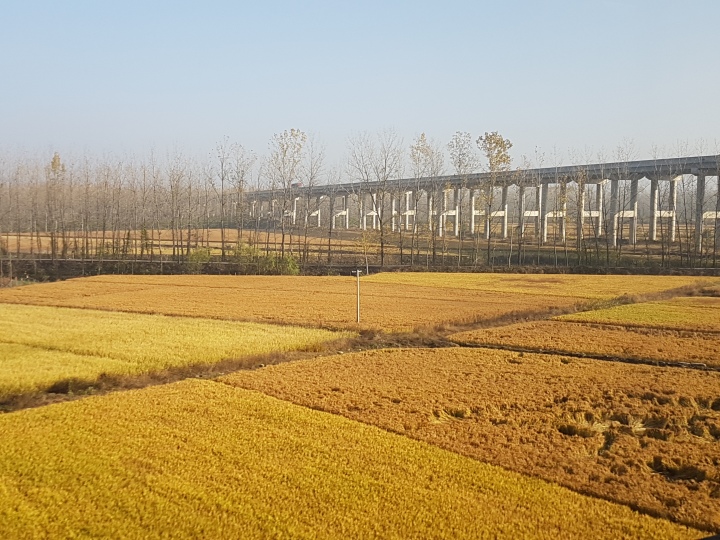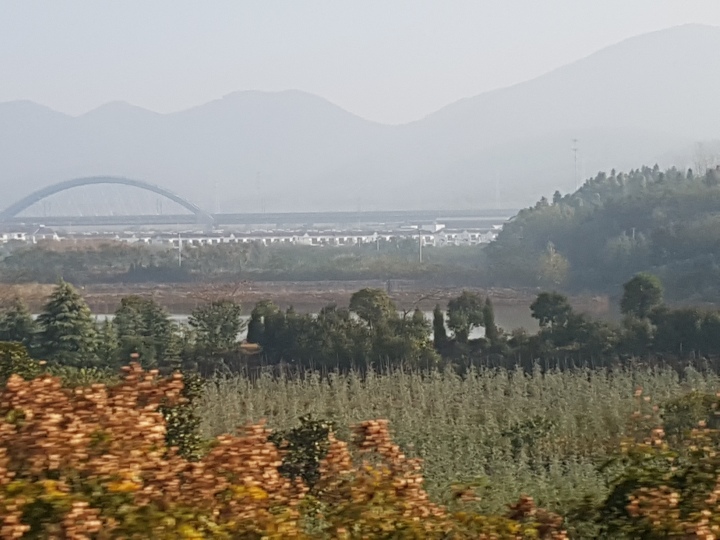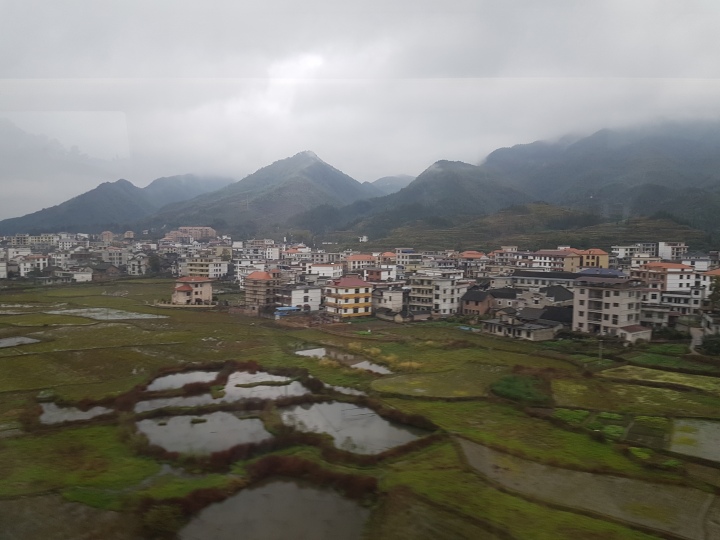






China has countless historic sites and ultra-modern cities to explore, but another great attraction is the countryside and a perfect way to see it is on China’s amazing high speed trains. Maybe you have had trouble “picturing” what China really looks like, so here are some scenes from my recent train travels, and some lessons I learned to make the travel relaxing, especially if, like me, you are a solo woman traveler who doesn’t speak Chinese!
For two months – October and November 2018 – I traveled and worked in China. When I wasn’t lecturing at USTC in Hefei, I was on a train. To be precise:
- 12 high-speed trains and one sleeper train,
- 9400 kilometers traveled,
- about 70 hours, not counting waiting time or processing time.

This was my seventh trip to China, so I specifically targeted regions, cities and tourist attractions new to me: ancient Pingyao in Shanxi, Xian and the Terracotta Warriors, Shanghai and the celebrated Wuzhen and Qibao ancient towns, Kunming with popular Lijiang and Dali in Yunnan, and giant fearsome Chongqing in the mighty Yangtze. valley. Hefei is almost in the middle, so I zigzagged to get them all in.
I arrived by plane in Beijing, travelled southwest to Pingyao and Xian, then southeast to reach Hefei. While in Hefei I made 2 trips to Shanghai, then I departed on my second “dream train trip” – one of the newest long-distance High Speed train from Shanghai to Kunming – 11 hours! It was the first trip, from Shanghai to Lhasa, that got me hooked!
After exploring a bit of Yunnan, I backtracked and went north to experience Chongqing before racing 9 hours south to catch a plane in Guangzhou.
Lesson one: travel light. You have to handle your own luggage, maybe stuff in under seats or heft it into the overhead rack. Of course, people will offer to help, but you don’t want to be a presumptuous foreigner so…. Most train stations have both escalators and lifts, but older stations like the one in the center of Shanghai may have only long flights of stairs. I admit packing light is a huge challenge for me, I was packing for 2 months for both travel and work. One strategy I sometimes use is to pack stuff I am really tired of, and discard it along the way. Another strategy is any new purchase must replace something that is about to be discarded or used up. The luggage is a fixed quantity that way.
Lesson two: plan, if you can, for one season. Most of inhabited China is in the Eastern half, it is very deep from north to south, and the weather and seasons change as you would expect in the Northern Hemisphere. So instead of a circle tour, zigzagging in a southerly direction meant I could enjoy fall for 2 months. By the time I reached balmy Kunming, Xian was getting very cold. Traveling with one seasonal wardrobe keeps luggage and hassle to a minimum. Of course, layering is the optimum strategy. I did have trouble finding laundry services, so think about how and where you will handwash.
3. Try to arrive in China early in the day. At 1:00 am, the airport at Beijing was virtually empty. No shops open meant no SIM card and that’s fairly critical on arrival in China. The buses had stopped running and the taxi to the train station cost about 300 RMB – which is a relatively a lot of Chinese currency to have in your pocket when you arrive. In the dark of night, I wasn’t always confident we were going where I wanted to go. The taxi driver actually asked me two or three times as he raced along in a darkened city (many Chinese cities turn off the lights in the middle of the night). It took an effort to stay calm!
4. Seriously know your train station and where it is. Almost all cities have more than one railway station, so check your ticket! Print your ticket or your destination station in Chinese so a driver knows exactly. I knew I was going to Beijing West but I didn’t know it was quite far from the airport and basically closed at night. It was hard to find an open entrance, although there was one I eventually found while dragging my luggage up and down stairs. I was one of only 3 people sleeping in the cavernous waiting room. But at least I wasn’t alone! And they don’t sell SIM cards at train stations.
5. Don’t assume there will be taxis waiting at train stations. Thankfully Booking.com makes is possible to request a car from your hotel, but don’t expect that all can do that, and it won’t be free. Usually, there may be a long wait in a taxi queue, and you may have a taxi driver shake his head… no, he will not take you… for reasons you may not understand. It is not worth trying to figure out. Just be a little aggressive and get into a clean, newer taxi with a younger driver most likely able to speak a little English. And be sure to have your destination printed in Chinese!
6. Hang on to your train ticket. Know exactly where you stashed it. First, it tells you your car and seat number. Trains don’t linger in stations, so you need to target your car quickly. Second, you will need to produce it en route. Train stewards note where passengers should be getting off – and they help you avoid the wrong station. Finally, you will run it through a ticket reader when you are about to board, but you NEED it again when you exit a station. Only once will you stand in the crush of arriving passengers at the ticket machine, with their luggage and eager families, searching all your pockets, only to remember you left it at your seat. Never a second time! Usually, there are several hundred people and 4-5 ticket readers. BUT always, there is a uniformed railway person who will swing open a gate somewhere on the edge of the crowd. My travel shirts have breast pockets just for train tickets.
7. Like me, you will probably want a window seat so you can snap photos at 300 kms per hour ?!?. So, with a smile and your camera in hand, ask a young person if you can trade seats. This has ALWAYS worked for me. I have hundreds of speed-blurred photos and indelible memories as proof.
8. High speed trains are simply fabulous. Clean and more comfortable than economy on any airline. They are almost always full, and passengers are typically relaxed and friendly. Older folks will offer you to share their snacks. You can try out your Chinese language skills. All facilities and toilets are well maintained, but as a rule, always carry a pack of tissues in your pocket. Always. Everywhere. And if, like me, you have trouble with squat toilets, the trains have standard western sitting toilets – a relief!! So do facilities designated for people with disabilities. My disability is my knees.
9. You have choices for class of travel on the CHR. This picture here is Business Class and it is most expensive. First Class is next and then Regular Class. It is confusing to Western travelers that Biz Class is superior to First Class – but that maybe reflects cultural values. I usually book First Class for any trip over 3 hours because it gives a little more space. Regular class is great too, though, as it can supply a genuine lesson in Chinese family relationships.
10. Sometimes a slow train is better. It is easy to cover great distances fast in China, but China is very mountainous, so long stretches are actually tunnels. Looooong stretches of tunnels. So for a sweeter view, choose older trains that will meander with the landscape changes. Booking trains is so easy and in the process, and on www.Trip.com you learn you can choose high-speed options only, or all options. The ones that take hours longer will be older, more localized and a more authentic Chinese experience because they are what typical Chinese people can afford.
11. Many older trains are sleeper trains running only at night on long trips. Others have, in addition to seats, 2 classes of sleeper cabins. The hard sleeper with 3 stacked bunks isn’t a bad experience, but the soft sleeper with 2 bunks is really comfortable. I’ve loved sleeping on trains, despite being with 3 total strangers in a soft sleeper cabin. There is no need or opportunity to slip into pyjamas – just wear sleepable clothes. And bring a smallish bag that will be stuffed under a low bunk so you don’t block the walking space for everyone else. Security is never an issue, but tuck your valuables behind or under you for peace of mind. Earplugs are a good idea. This year, I took the sleeper train from Dali to Kunming. I was backtracking so I’d already seen the countryside. It was a 2-double-decker sleeper train for tourists, and it saved the price of a hotel room. Young people volunteered help whenever I looked confused. It works.
12. Train food is possible but sometimes questionable. Thankfully, a fruit cart usually circulates up and down the cars. Remember to bring snacks and beverages, and your hot water bottle/cup with some tea or coffee packets. Hot water is easily available in every car. Coffee is not, in any car! Beer may be available from the snack bar. There is an amazing new service, too, that allows you to order by QR code from you seat for delivery at the next station. I tried but I didn’t have a Chinese credit card.
I am just kidding about the crisp water dragonfly and the enema sausage.
13. It is a huge benefit to travel solo in China, especially as an older woman. People continuously offer assistance and invitations. I think they feel sorry for someone alone, so they are super kind. I had to get used to being called Auntie. It is just so easy to get around with smiles and apologies for gaffs and direct requests for help.
14. Be ready for arrival. Have your hotel reservation printed in Chinese for a taxi driver and have some small Chinese cash. Estimate the distance so that you are not shocked to still be riding along at breakneck speed after 45 or more minutes. While I have sometimes been uncomfortable, I have never had a driver take other than a direct route. Best case, follow along on Google maps if you have a SIM and VPN.
15. Avoid chain hotels. They will be sited in a location that has no local character – the old village having been bulldozed. One of the best morning routines – after your long train ride – is to step out among the locals, but you need to be early to catch the morning street market.
So now you ready to relax and enjoy watching the variety of China fly past.




























































2 thoughts on “China at 300 kms/hr: Train Travel Tips so you Relax and Enjoy the View”